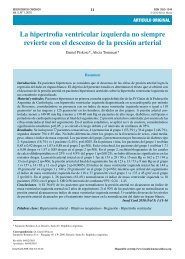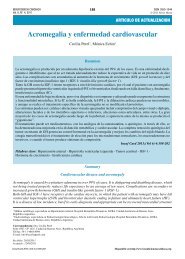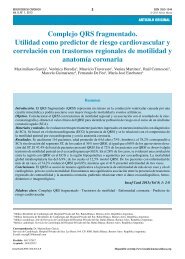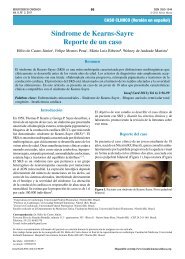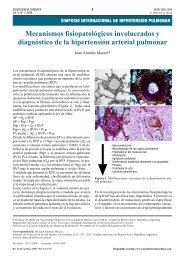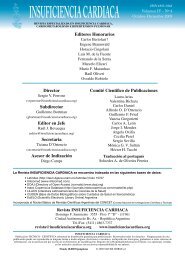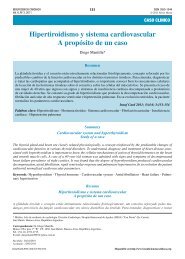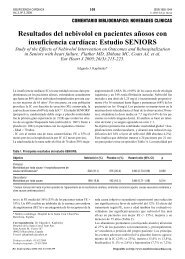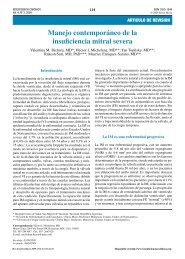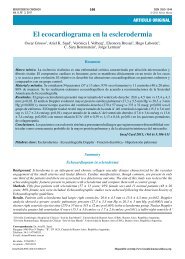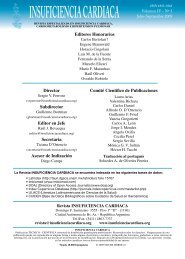Eisenmenger syndrome in a patient with atrial septal defects Study ...
Eisenmenger syndrome in a patient with atrial septal defects Study ...
Eisenmenger syndrome in a patient with atrial septal defects Study ...
Create successful ePaper yourself
Turn your PDF publications into a flip-book with our unique Google optimized e-Paper software.
INSUFICIENCIA CARDIACA<br />
Vol. 5, Nº 4, 2010<br />
205 F Azevedo ISSN Simão 1850-1044 et al.<br />
<strong>Eisenmenger</strong> <strong>syndrome</strong> and <strong>atrial</strong> © 2010 <strong>septal</strong> Silver <strong>defects</strong> Horse<br />
CASE REPORT (English version)<br />
<strong>Eisenmenger</strong> <strong>syndrome</strong> <strong>in</strong> a <strong>patient</strong><br />
<strong>with</strong> <strong>atrial</strong> <strong>septal</strong> <strong>defects</strong><br />
<strong>Study</strong> of a case<br />
Fábio Azevedo Simão 1 , Felipe Montes Pena 1 , Fernanda Arêdo Carvalho 2 ,<br />
Carlos Augusto Cardozo de Faria 3<br />
Ver<br />
Summary<br />
The <strong>Eisenmenger</strong> <strong>syndrome</strong> (ES) represents the most advanced form of pulmonary arterial hypertension associated<br />
<strong>with</strong> congenital heart <strong>defects</strong> (CHD). Adults <strong>with</strong> CHD represent an expand<strong>in</strong>g population requir<strong>in</strong>g tertiary care<br />
<strong>in</strong> the long term. Around 8% of <strong>patient</strong>s <strong>with</strong> CHD and 11% of those <strong>with</strong> shunts from left to right develop the<br />
framework for the ES. Efforts are directed at treatment for reduc<strong>in</strong>g pulmonary vascular resistance, left to right<br />
shunt, cyanosis, morbidity and mortality. We present a case of female, 41 years old, who had cyanosis at rest,<br />
lower limb edema and <strong>atrial</strong> <strong>septal</strong> defect type communication <strong>in</strong>ter<strong>atrial</strong> diagnosed <strong>in</strong> echocardiography who was<br />
tackled drug <strong>with</strong> calcium channel blockers.<br />
Insuf Card 2010 (Vol 5)4:205-208<br />
Keywords: Pulmonary hypertension - <strong>Eisenmenger</strong> - Congenital heart disease<br />
Introduction<br />
In 1897, Viktor <strong>Eisenmenger</strong> described a case of a<br />
<strong>patient</strong> <strong>with</strong> cyanosis and dyspnea s<strong>in</strong>ce childhood,<br />
who died <strong>with</strong> massive hemoptysis at 32 years old.<br />
The autopsy showed a ventricular <strong>septal</strong> defect and<br />
severe pulmonary vascular disease 1 . In 1958, Paul Wood<br />
described the term <strong>Eisenmenger</strong> complex, consist<strong>in</strong>g of<br />
“pulmonary hypertension <strong>in</strong> systemic levels <strong>with</strong> reversed<br />
or bidirectional shunt or a ventricular <strong>septal</strong> defect”.<br />
Subsequently, the term <strong>Eisenmenger</strong> <strong>syndrome</strong> (ES) has<br />
been used to describe the pulmonary vascular disease<br />
and cyanosis result<strong>in</strong>g from the connection between the<br />
pulmonary and systemic circulation (as <strong>in</strong> <strong>atrial</strong> <strong>septal</strong><br />
<strong>defects</strong>, ventricular <strong>septal</strong> defect, patent ductus arteriosus<br />
and aortopulmonary w<strong>in</strong>dow) 2 .<br />
Therefore, <strong>Eisenmenger</strong> <strong>syndrome</strong> represents the most<br />
advanced form of pulmonary arterial hypertension (PAH)<br />
associated <strong>with</strong> congenital heart <strong>defects</strong>. Adults <strong>with</strong><br />
congenital heart disease (CHD) represent an expand<strong>in</strong>g<br />
population that requires long-term tertiary care. About<br />
5% to 10% of them present PAH of variable severity that<br />
affects quality of life, morbidity and mortality 3 .<br />
We report the case of a 41-year-old female who presented<br />
<strong>with</strong> very high pulmonary artery pressure (PAP), lower<br />
extremity edema, cyanosis of the extremities and <strong>atrial</strong><br />
<strong>septal</strong> defect, fulfill<strong>in</strong>g the criteria for ES.<br />
Case report<br />
We present the case of a 41-year-old woman born <strong>in</strong><br />
Rio de Janeiro, who was admitted to hospital <strong>with</strong> signs<br />
1<br />
Specialization <strong>in</strong> Cl<strong>in</strong>ical Cardiology. Flum<strong>in</strong>ense Federal University. University Hospital Antonio Pedro (HUAP). Niterói. Rio de Janeiro. Brazil.<br />
2<br />
Pregrade <strong>in</strong> Medic<strong>in</strong>e. Flum<strong>in</strong>ense Federal University. Niterói. Rio de Janeiro. Brazil.<br />
3<br />
PhD <strong>in</strong> Cl<strong>in</strong>ical Investigation. Flum<strong>in</strong>ense Federal University. University Hospital Antonio Pedro (HUAP). Niterói. Rio de Janeiro. Brazil.<br />
Correspondence: Dr. Felipe Montes Pena<br />
Rua Mariz e Barros, número 71. Apartamento 601. Bairro Icaraí. Cep 24220-120. Niterói. Río de Janeiro. Brazil.<br />
E-mail: fellipena@yahoo.com.br; fellipena@hotmail.com<br />
Received: June 28, 2010<br />
Accepted: September 25, 2010<br />
Insuf Card 2010; (Vol 5) 4:205-208<br />
Available at http://www.<strong>in</strong>suficienciacardiaca.org
INSUFICIENCIA CARDIACA<br />
Vol. 5, Nº 4, 2010<br />
Figure 1. Pulmonary <strong>atrial</strong> protrusion at chest X-ray.<br />
of progressive dyspnea on m<strong>in</strong>imal effort, which began<br />
six months ago <strong>with</strong> a significant worsen<strong>in</strong>g <strong>in</strong> the last<br />
three months functional class, pleuritic chest pa<strong>in</strong> <strong>with</strong><br />
non-productive cough and severe edema of the lower<br />
extremities. Medical history recounts drug treatment<br />
hypertension, heart murmur <strong>in</strong> childhood and smok<strong>in</strong>g.<br />
206 F Azevedo Simão et al.<br />
<strong>Eisenmenger</strong> <strong>syndrome</strong> and <strong>atrial</strong> <strong>septal</strong> <strong>defects</strong><br />
Cardiovascular auscultation physical exam<strong>in</strong>ation showed<br />
a hypophonetic S2 <strong>with</strong> sisto-diastolic murmur <strong>in</strong> the<br />
lung area. He was undergo<strong>in</strong>g tachypnea, cyanosis of the<br />
f<strong>in</strong>gertips at rest, and <strong>in</strong>creased positive sign Dressler on<br />
palpation of the chest.<br />
Complementary exam<strong>in</strong>ations were requested, such<br />
as biochemistry, rheumatic activity evidence, thyroid,<br />
hemoglob<strong>in</strong> electrophoresis, <strong>with</strong><strong>in</strong> normal parameters. It<br />
was requested a chest radiography, show<strong>in</strong>g a significant<br />
protrusion <strong>in</strong> the area of the pulmonary artery (Figure 1),<br />
electrocardiogram identified first degree atrioventricular<br />
block <strong>with</strong> right bundle branch block (Figure 2), and<br />
transthoracic echocardiography (TTE) showed an <strong>in</strong>crease<br />
<strong>in</strong> the atria, significant tricuspid regurgitation, enlarged<br />
right ventricle, PAP of 123.7 mm Hg and ventricular<br />
ejection fraction (LVEF) 47% (Figure 3). Subsequently, we<br />
performed transesophageal echocardiography (TEE) that<br />
demonstrated the presence of an <strong>atrial</strong> <strong>septal</strong> defect (ASD)<br />
<strong>with</strong> left to right shunt (Figure 4). At thorax computed<br />
tomography the ma<strong>in</strong> f<strong>in</strong>d<strong>in</strong>g was a protrusion of the<br />
pulmonary artery (Figure 5). A room air arterial blood<br />
gases revealed the follow<strong>in</strong>g data: pH=7.43, pCO 2<br />
=23.4<br />
mm Hg, pO 2<br />
=53.9 mm Hg and O 2<br />
saturation=89.8%.<br />
Based on the cl<strong>in</strong>ical case proposed we diagnosed ES <strong>with</strong><br />
high PAP, cyanosis of the limbs at rest and the presence<br />
of ASD.<br />
Initially we opted for drug treatment, suggest<strong>in</strong>g the<br />
use of diltiazem <strong>in</strong> progressive doses of 720 mg/day,<br />
Figure 2. Electrocardiographic changes accord<strong>in</strong>g to described pathology.
INSUFICIENCIA CARDIACA<br />
Vol. 5, Nº 4, 2010<br />
207 F Azevedo Simão et al.<br />
<strong>Eisenmenger</strong> <strong>syndrome</strong> and <strong>atrial</strong> <strong>septal</strong> <strong>defects</strong><br />
Figure 3. Pulmonary hypertension echocardiographic demonstration.<br />
accord<strong>in</strong>g to Venetia Consensus 4 , furosemide 20 mg/day<br />
and spironolactone 25 mg/day. After 15 days of use <strong>in</strong><br />
<strong>in</strong>creas<strong>in</strong>g doses of calcium antagonist, diltiazem, there<br />
was a 20% drop <strong>in</strong> the PAP (98 mm Hg) measured by TTE<br />
by the same previous operator. Currently, the <strong>patient</strong> is<br />
stable as an out<strong>patient</strong>.<br />
Discussion<br />
The <strong>in</strong>cidence of CHD <strong>in</strong> the general population is 1%.<br />
About 8% of <strong>patient</strong>s <strong>with</strong> CHD and 11% of those <strong>with</strong><br />
left to right shunt develops a framework for ES 5 . Increased<br />
pulmonary vascular resistance can occur between 5%<br />
and 10% of <strong>patient</strong>s <strong>with</strong> untreated <strong>atrial</strong> <strong>septal</strong> defect,<br />
predom<strong>in</strong>antly <strong>in</strong> women. The pathogenesis of PAH <strong>in</strong><br />
some <strong>patient</strong>s is unknown. Generally, we consider the<br />
presence of an ES when the ASD is large and not restrictive,<br />
<strong>in</strong> presence of cyanosis at rest 6 . In the description of this<br />
case we observed, accord<strong>in</strong>g to literature, a <strong>patient</strong> <strong>with</strong><br />
PAH, ASD and cyanosis at rest.<br />
Physical exam<strong>in</strong>ation of these <strong>patient</strong>s is varied and can<br />
reveal central cyanosis that may be affected due to <strong>in</strong>crease<br />
vascular resistance, when subjected to higher temperatures,<br />
exercise, fever, high altitude or systemic <strong>in</strong>fection. The<br />
signs of PAH on physical exam<strong>in</strong>ation present the palpable<br />
pulmonary valve closure and hyperphonetic second heart<br />
sound components. Blood pressure is usually palpable or<br />
decreased. There may be a diastolic murmur of pulmonary<br />
regurgitation (Graham-Steel) 7 .<br />
For differential diagnosis <strong>with</strong> additional tests <strong>in</strong> those<br />
<strong>patient</strong>s who present at chest radiography a prom<strong>in</strong>ent<br />
pulmonary artery and ventricular <strong>septal</strong> defect (VSD),<br />
the cardiothoracic ratio is decreased, while the ASD<br />
carriers have cardiomegaly <strong>with</strong> dilated right ventricular<br />
secondary to <strong>in</strong>creased pressure load 8 . TTE can identify<br />
valvular or cardiac <strong>defects</strong>. Associated Doppler allows<br />
identification of shunts. TEE is useful <strong>in</strong> those <strong>patient</strong>s<br />
<strong>in</strong> whom there is difficulty <strong>in</strong> identify<strong>in</strong>g the pulmonary<br />
artery pressure or <strong>septal</strong> <strong>defects</strong> 9 . Magnetic resonance<br />
imag<strong>in</strong>g (MRI) can identify <strong>in</strong>tracardiac <strong>defects</strong> and<br />
patent ductus arteriosus, especially <strong>in</strong> those <strong>with</strong> previous<br />
cardiac surgery. MRI can detect shunts from left to right<br />
or bidirectional, but have no obligation to quantify the<br />
shunt. Cardiac catheterization is very useful to detect,<br />
locate and quantify the shunt and to determ<strong>in</strong>e the severity<br />
of pulmonary vascular disease, however it has fallen <strong>in</strong>to
INSUFICIENCIA CARDIACA<br />
Vol. 5, Nº 4, 2010<br />
208 F Azevedo Simão et al.<br />
<strong>Eisenmenger</strong> <strong>syndrome</strong> and <strong>atrial</strong> <strong>septal</strong> <strong>defects</strong><br />
Figure 4. Transthoracic Doppler echocardiography show<strong>in</strong>g <strong>in</strong>ter<strong>atrial</strong><br />
communication presence.<br />
Figure 5. Pulmonary artery significant dilation at computed<br />
tomography.<br />
disuse as advances <strong>in</strong> echocardiography have helped to<br />
achieve these measurements 10 .<br />
Efforts are directed to a treatment to reduce pulmonary<br />
vascular resistance, left to right shunt, cyanosis, morbidity<br />
and mortality. These measures have been disappo<strong>in</strong>t<strong>in</strong>g.<br />
Calcium channel blockers lower systemic <strong>atrial</strong> pressure<br />
and decrease shunt, and may lead to syncope and sudden<br />
death. Their use is controversial, exist<strong>in</strong>g results of good<br />
development and at the same time, adverse outcomes <strong>in</strong><br />
others. Oxygen therapy is not rout<strong>in</strong>ely recommended but<br />
is useful <strong>in</strong> <strong>patient</strong>s <strong>with</strong> profound hypoxemia, dyspnea<br />
at rest or limited activity 11,12 .<br />
The long-term prognosis of <strong>patient</strong>s <strong>with</strong> ES is better than<br />
other conditions associated <strong>with</strong> PAH, such as primary<br />
pulmonary hypertension. These <strong>patient</strong>s have a survival<br />
of 80% at 10 years, 77% at 15 years and 42% at 25<br />
years. The prognosis is not <strong>in</strong>fluenced by the location of<br />
the <strong>in</strong>tracardiac defect. Variables associated <strong>with</strong> worse<br />
long-term prognosis are: syncope, right cavity <strong>in</strong>flation<br />
pressure and severe hypoxemia 13 . The <strong>patient</strong> described<br />
has a rare disease <strong>with</strong> atypical presentation, consider<strong>in</strong>g<br />
that age is not typical of the disease or the response to<br />
treatment <strong>with</strong> diltiazem at high doses, ma<strong>in</strong>ta<strong>in</strong><strong>in</strong>g a<br />
good outcome so far.<br />
References<br />
1. <strong>Eisenmenger</strong> V. Die angeborenen Defects des Kammerscheidewand<br />
des Herzen. Z Kl<strong>in</strong> Med 1897;32(Suppl):1-28.<br />
2. Wood P. The <strong>Eisenmenger</strong> <strong>syndrome</strong> or pulmonary hypertension<br />
<strong>with</strong> reversed central shunt. Br Med J 1958;2:701-709.<br />
3. Kidd L, Driscoll DJ, Gersony WM, Hayes CJ, Keane JF,<br />
O’Fallon WM, Pieroni DR, Wolfe RR, Weidman WH. Second<br />
natural history study of congenital heart <strong>defects</strong>: results of<br />
treatment of <strong>patient</strong>s <strong>with</strong> ventricular <strong>septal</strong> <strong>defects</strong>. Circulation<br />
1993;87:I38-I51.<br />
4. Galiè N, Rub<strong>in</strong> LJ, eds. Pulmonary arterial hypertension. Epidemiology,<br />
Pathobiology, assessment, and therapy. J Am Coll<br />
Cardiol 2004;43(Suppl S):1S-90S.<br />
5. Young D, Mark H. Fate of the <strong>patient</strong> <strong>with</strong> the <strong>Eisenmenger</strong><br />
<strong>syndrome</strong>. Am J Cardiol 1971;28:658-669.<br />
6. Webb G, Gatzoulis MA. Atrial <strong>septal</strong> <strong>defects</strong> <strong>in</strong> the adult: recent<br />
progress and overview. Circulation 2006;114:1645-1653.<br />
7. Vongpatanas<strong>in</strong> W, Brickner ME, Hillis LD, Lange RA.<br />
The <strong>Eisenmenger</strong> <strong>syndrome</strong> <strong>in</strong> adults. Ann Intern Med<br />
1998;128:745-755.<br />
8. Rees RS, Jerrerson KE. The <strong>Eisenmenger</strong> <strong>syndrome</strong>. Cl<strong>in</strong><br />
Radiol 1967;18:366-371.<br />
9. Chen WJ, Chen JJ, L<strong>in</strong> SC, Hwang JJ, Lien WP. Detection of<br />
cardiovascular shunts by transesophageal echocardiography <strong>in</strong><br />
<strong>patient</strong>s <strong>with</strong> pulmonary hypertension of unexpla<strong>in</strong>ed cause.<br />
Chest 1995;107:8-13.<br />
10. Boehrer JD, Lange RA, Willard JE, Grayburn PA, Hillis LD.<br />
Advantages and limitations of methods to detect, localize, and<br />
quantitate <strong>in</strong>tracardiac right-to-left and bidirectional shunt<strong>in</strong>g.<br />
Am Heart J 1993;125:215-220.<br />
11. Wong CK, Yeung DW, Lau CP, Cheng CH, Leung WH. Improvement<br />
of exercise capacity after nifedip<strong>in</strong>e <strong>in</strong> <strong>patient</strong>s <strong>with</strong><br />
<strong>Eisenmenger</strong> <strong>syndrome</strong> complicat<strong>in</strong>g ventricular <strong>septal</strong> defect.<br />
Cl<strong>in</strong> Cardiol 1991;14:957-961.<br />
12. Wimmer M, Schlemmer M. Long-term hemodynamic effects of<br />
nifedip<strong>in</strong>e on congenital heart disease <strong>with</strong> <strong>Eisenmenger</strong>’s mechanism<br />
<strong>in</strong> children. Cardiovasc Drugs Ther 1992;6:183-186.<br />
13. Saha A, Balakrishnan KG, Jaiswal PK, Venkitachalam<br />
CG, Tharakan J, Titus T, et al. Prognosis for <strong>patient</strong>s <strong>with</strong><br />
<strong>Eisenmenger</strong> <strong>syndrome</strong> of various aetiology. Int J Cardiol<br />
1994;45:199-207.




